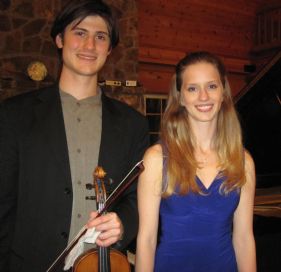|
Symphony
SRS SEASON ENDS WITH RESOUNDING TA-TA-TA-BANG
by Terry McNeill
Sunday, June 1, 2025
Symphony
YOUTHFUL VIRTUOSITY ON DISPLAY AT USO'S MAY CONCERTS
by Peter Lert
Saturday, May 17, 2025
Symphony
MYSTICAL PLANETS AND LIVELY GERSHWIN ORTIZ AT FINAL SRS CONCERT
by Peter Lert
Sunday, May 4, 2025
Symphony
VSO'S CONCERT MUSIC OF TIME, MUSIC OF PLACE
by Peter Lert
Sunday, April 27, 2025
Choral and Vocal
VOCAL ELEGANCE AND FIRE AT THE 222'S RECITAL APRIL 26
by Pamela Hicks Gailey
Saturday, April 26, 2025
CANTIAMO SONOMA SINGS AN INSPIRED GOOD FRIDAY MOZART REQUIEM CONCERT
by Pamela Hicks Gailey
Friday, April 18, 2025
DRAMATIC SHOSTAKOVICH SYMPHONY CLOSES PHILHARMONIC'S 25TH SEASON
by Terry McNeill
Sunday, April 13, 2025
LARGE COLLEGE OF MARIN AUDIENCE GREETS STOPHER ARTISTRY
by Terry McNeill
Saturday, April 5, 2025
Chamber
FRISSON DELIVERS SHIVERS OF DELIGHT
by Abby Wasserman
Sunday, March 30, 2025
OLD AND MOSTLY NEW IN SRS MARCH CONCERT IN WEILL
by Peter Lert
Saturday, March 22, 2025
|
 |
 Nigel Armstrong and Elizabeth Dorman Jan. 5 |
NATIVE VIRTUOSITY
by Terry McNeill
Saturday, January 5, 2013
Violinist Nigel Armstrong is becoming a virtuoso staple for North Bay concerts, having played locally over the past three years in private homes, with symphonic groups and in several formal recitals. January 5 found him giving a benefit recital for the Sonoma Classical Music Society in his Sonoma hometown in the west side Kenny residence. It was an exceptional afternoon of music making.
With pianist Elizabeth Dorman, Mr. Armstrong opened with Beethoven’s Romance in G Major, a 10-minute work usually heard with orchestra. The piano reduction worked well, and Ms. Dorman was attentive to the soloist’s suave melodic line, carefully matching a lovely ascending and descending violin line at the midpoint.
The afternoon’s chief work was Schumann’s A Minor Sonata, Op. 105, a surging romantic piece from 1851 that Mr. Armstrong was playing for the first time in public. The warm partnership of the Beethoven Romance continued throughout this restless Sonata. The many modulations in the opening movement (“with passionate expression”) were deftly highlighted by the violinist, and his vibrato was wide and often pulsating. The short intermezzo was well played, ending in a soft series of pizzicato violin notes coupled with expressive, almost somber chords from the piano. Schumann’s restless energy burst forth in the finale. The duo performed the sudden dynamic contrasts pungently, and the rush to a tragic end moved the audience of 50 to loud applause.
Two movements from Bach’s solo Third Sonata (BWV 1005) began the second half. Mr. Armstrong played the opening Adagio soulfully and the long three-part fugue masterfully. A Bach work for solo piano came next, the popular B Flat Partita (BWV 825) with seven brief movements. Ms. Dorman’s committed playing was often too loud, and in the flowing first movement arabesques her rhythms were unstable. She does enjoy extravagant ornamentation on repeats but has yet to acquire much color in her playing.
Ending the recital were Brahms’ Hungarian Dances Four and Five in the Joachim arrangements. Every bit of these virtuosic and gypsy-like compositions was played with soaring vitality by Mr. Armstrong. He often leaned down to his pianist to underscore a phase, beginning with a nod or a wave of his fleet bow tip. The double and sporadic triple stops were faultless.
As an encore treat for violin buffs, Mr. Armstrong played Ernst’s “Variations on The Last Rose of Summer,” the sixth of his Polyphonic Etudes from the 1860s. Curiously, the final two variations and finale were omitted. But no matter, what Mr. Armstrong played was coin of the fiddler’s realm and uniquely thrilling.
The Sonoma Classical Music Society’s spring season of three more concerts can be seen at www.sonomaclassical.org.
Bronislaw Irving contributed to this review
|

